2002 North Main Street
Santa Ana, California 92706
TEL: 714.567.3600
Under the Hilt: Identifying Three Japanese Swords
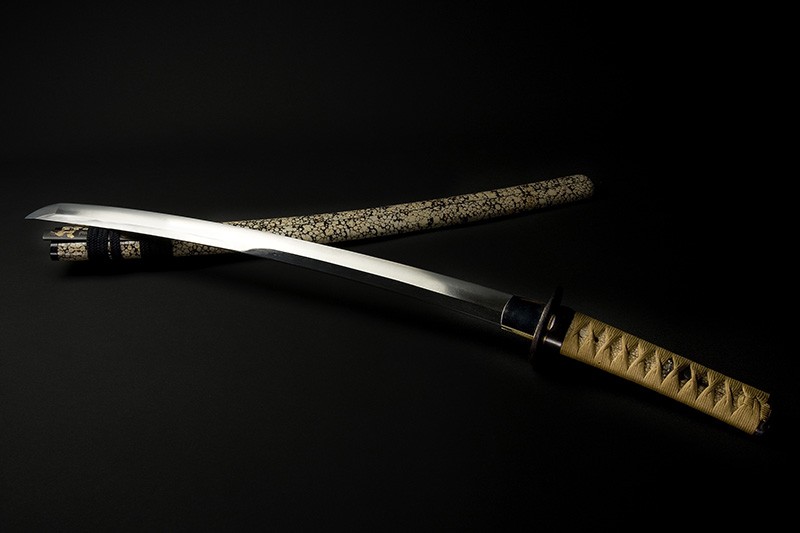 |
| Short Sword (Wakizashi), 15th to 19th Century Tsuguhiro (Japanese, active 1469-1521), Jiryūsai Tomohide (Japanese, 1778-1847) and Seiyōken Akitada (Japanese, active 19th Century); Fukui Prefecture, Chūbu Region, Japan and Nagasaki, Kyushu Region or Tokyo, Kantō Region, Japan Steel, manta ray skin, lacquer, silk and iron; 2 3/4 x 2 3/8 x 27 1/4 in. 2002.38.1 Gift of Kathleen J. Steyer |
Who-Tang Scan
Archeologists, researchers, and investigators will all tell you that the best way to learn more about something is to look just beneath the surface. This is certainly the case with the swords used by samurai, Japan’s pre-modern military caste. These blades are almost exclusively signed on their tangs, the part of the blade fitted into the grip. With the help of Riccardo Franci, curator for the Bowers Museum’s Knights in Armor exhibition and the Curator of the Armory at the Museo Stibbert, we looked just below the surface of these swords and in the process learned a great deal about where and when the swords were made, who the makers were, and how they might have been used throughout history.
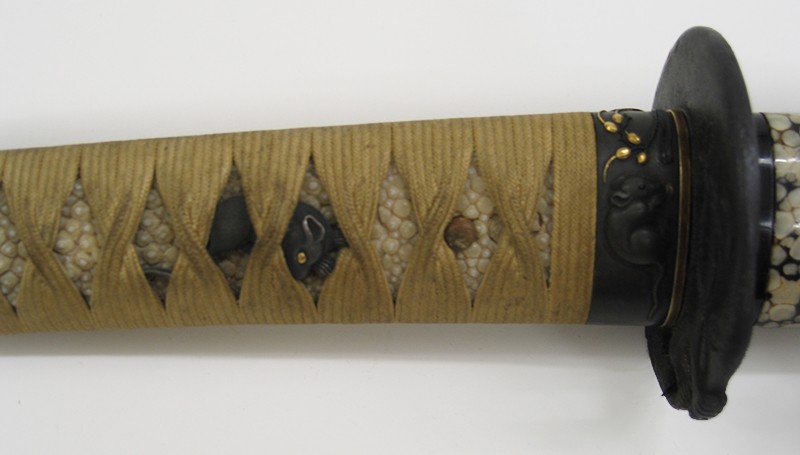 |
| Detail of 2002.38.1 |
Daisho Time
Japanese swords fall into many separate classes depending on length, curvature, and other determining factors. In this post we are looking at the two sword types most commonly used by samurai: the larger katana and the wakizashi (literally big and small), collectively referred to as the daisho. As longer blades, katanas are more useful in combat and dueling, but when entering a house, they would be left on a rack provided for just that purpose. Generally, as a gesture of good will the katana would be stored in a way that made it difficult for the samurai to draw it quickly. The wakizashi on the other hand was a staple worn at all times—it would even stay under a samurai’s pillow when he slept.
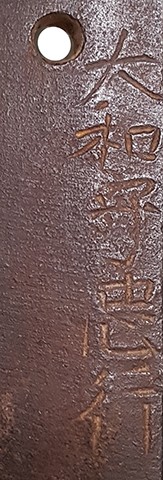 |
| Detail of Sword (Katana), early 18th to 20th Century Tadayuki (Japanese, active 1681-1711); Ōita Prefecture, Kyushu Region, Japan Steel, brass, cloth; 38 7/8 x 3 in. 2003.50.55 Gift of William R. Moran, photograph taken by Riccardo Franci |
First Sword-er of Business
All three swords featured in this post share several commonalities, but the similarity that most informs the design of the first two blades is that they were used by Japanese officers during World War II. Most World War II-era officer swords were mass-produced, machine-made blades; these, however, were simply retrofitted for use in a 20th Century war. As promised, this can best be detected by looking at the tang. The name Yamato no Kami Tadayuki on this blade’s tang indicates that despite the low quality of the mounting, the blade actually dates to 1711 or before. This also happens to be the longest of the three blades, so it is worth explaining how katanas and wakizashi are distinguished. It comes down to shaku, an old Japanese unit of measurement that is roughly equivalent to 14 in. If a sword is between one and two shaku from the notch for the sword guard to the tip, then it tends to be a wakizashi. If it is between two and three shaku, then it is usually a katana.
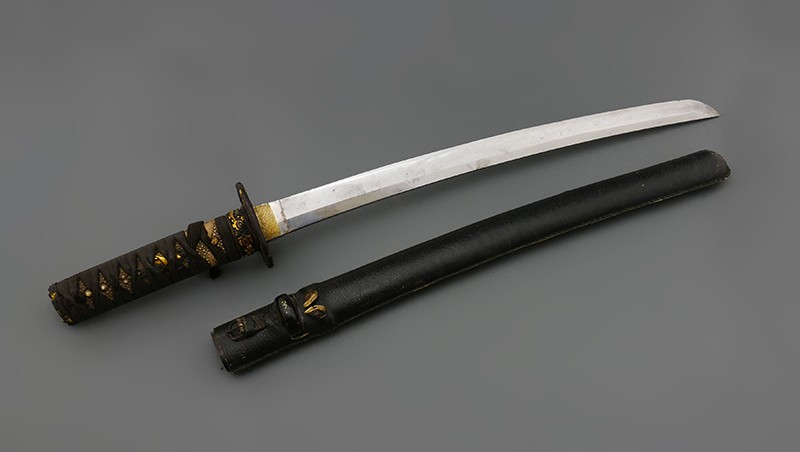 |
| Short Sword (Wakizashi), 16th Century Bishū Osafune Sukesada Saku (Japanese, active 16th Century); Okayama Prefecture, Chūgoku Region, Japan Steel, leather, manta ray skin, lacquered wood and newspaper; 24 1/2 in. 7475 Loan Courtesy of Major Bruce A. de Bourbon Conde |
Second Duty Wakizashi
By measuring between one and two shaku the second and third swords are both wakizashi. Despite this length difference, a close examination of the first of these short swords especially shows some similarities to the above katana. First off, the blade was made well before the mounting, during Japan’s bloody 16th Century. The Sengoku or Warring States Period lasted roughly from 1467-1600 and was a time of constant warfare as clans vied for control of the nation. It was in this crucible that this utilitarian blade was produced. It’s signature mark is simple, without honorifics, meaning that this was intended for use of the battlefield and little else. The sword’s history hardly ends there, though. The mounting was completely replaced in either the 17th or 18th Century. The leather covering for the sheath is an even later addition that would have come during World War II.
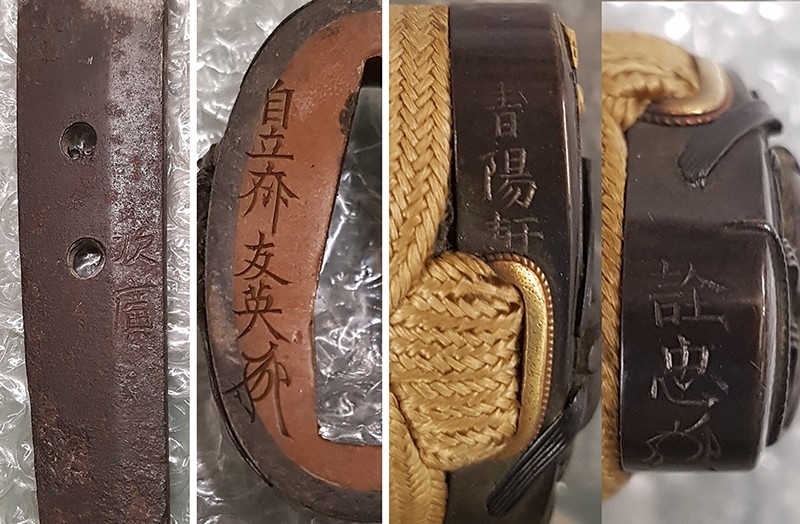 |
| The three signatures on 2002.38.1, photograph taken by Riccardo Franci |
Thrice Made, Mice Motifs
The final sword in this post is another wakizashi. It is without a doubt the finest of the three. In fact, the materials and craftsmanship of this samurai sword make it easy to rank it as one of the Bowers' most beautiful and highly regarded objects. The scabbard, or sheath, is made from manta ray belly skin and is smoothed and filled with lacquer. The hilt is covered in unfinished manta ray skin and then wrapped in braided silk thread. The rat motif, reoccurs on both sides of the scabbard tucked under wrapped threads, at each end of the pommels, and as the round sword guard. In Japanese culture, the rat is a symbol of abundance as only the wealthy could have enough excess grain to attract rats. What is particularly interesting about the sword is the signatures. The earliest signature is in the usual location on the blade: Tsuguhiro, a swordsmith active at the very beginning if the Sengoku Period. His blades are held in high esteem and this is an excellent example of his craftsmanship. The collar, a much later addition, also has a signature on its underside by Jiryūsai Tomohide. This alone would not be unusual; blade smithing and sword mounting were very different trades. Here, though, there is a third signature on the pommel attributed to Seiyōken Akitada, alive during roughly the same period as Tomohide. Usually the entire mounting would be created and signed by one craftsman. Potential answers abound, but we can only speculate as to why two artists would have worked on this sword’s mounting.
Big thank you to Riccardo Franci for his help researching these swords. Some text on 2002.38.1 is taken from Japanese Sword, a 2006 post on the Bowers Blog. Text and images may be under copyright. Please contact Collection Department for permission to use. References are available on request. Information subject to change upon further research.

Comments 4
I have some pics of a beautiful sword from my Marine grandfather picked up on the battlefield of Guam in 1943. Its truly impressive can I send some pictures too you? Thanks, Dan
Can you help me identify a sword?. I have photo of the inscriptions under the hilt
Great information. The wakizashi definitely looks great and I love the history behind it. Do you also know what kind of baldrics were used for these types of swords?
I'm trying to get more info on a sword I got at a flea market I have pictures any information will be great thanks